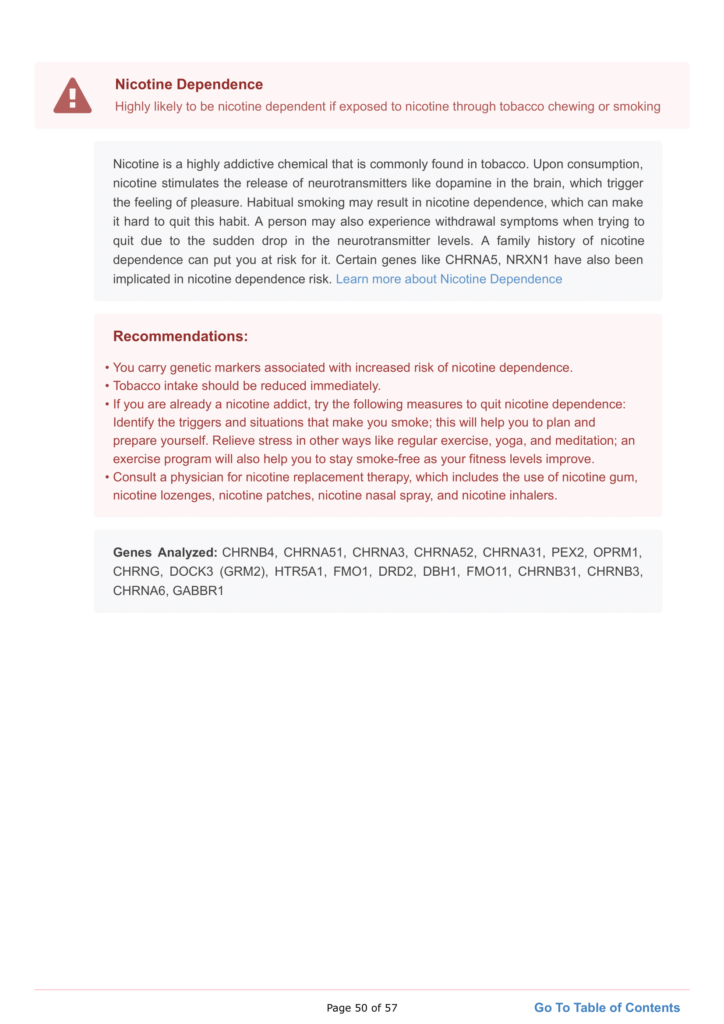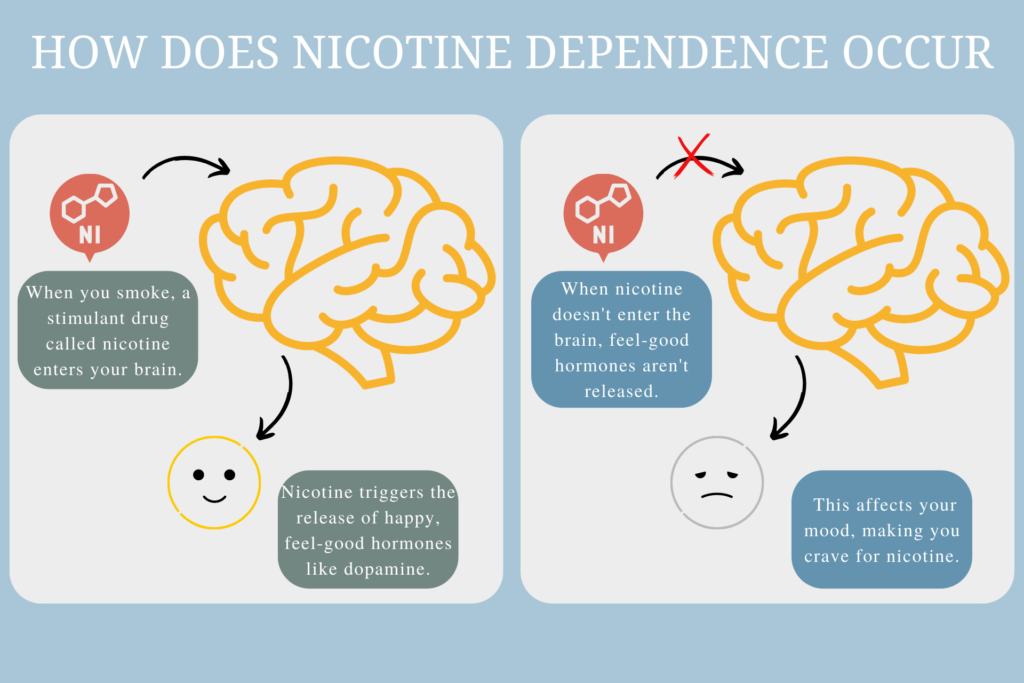Xcode Life's Nicotine Dependence DNA Report
A 2020 study identified 5 regions of the genome linked to nicotine dependence.
In the sample report below, we've attempted to analyze some important genes that increase the risk for nicotine dependence.
You can identify your genetic risk of insomnia by using your 23andMe DNA data and placing an order for the Gene Nutrition Report.

Nicotine Dependence: Introduction
Nicotine is a nitrogen-containing chemical and is a highly addictive substance. It is mainly found in tobacco and is primarily consumed by inhaling the smoke of tobacco cigarettes.
Nicotine produces ‘pleasurable and pleasing’ effects on the brain.
With regular smoking, you tend to get used to these positive feelings. Going without a smoke can make you experience unwanted effects - this indicates nicotine dependence.
According to the CDC, smoking is the leading cause of preventable death in the U.S.
A study suggested that smoking is responsible for 1 in every 5 deaths in the U.S.
Symptoms of Nicotine Dependence
The symptoms vary amongst individuals and also differ based on the level of dependence. Some signs to watch out for include:
- A history of at least one unsuccessful attempt to quit smoking
- Withdrawal symptoms like irritability, mood swings, insomnia, restlessness, increased hunger, and anxiety
- Social withdrawal - an unwillingness to participate in any activities or go to any places that discourage smoking.
Causes Of Nicotine Dependence
The addictive quality of nicotine is what causes nicotine dependence.
Nicotine triggers the release of the happy hormone dopamine.
This pleasure response is what smokers chase after.
Smoking also increases the heart rate, boosting the noradrenaline hormone. The increased hormone levels enhance mood and concentration.
People who smoke nicotine start craving the dopamine rush. When they abstain from smoking for a few hours, their hormone levels start to drop, and they start to experience undesired effects like irritability and anxiety.
Brief History of Nicotine/Tobacco Usage
Nicotiana tabacum is the type of nicotine found in tobacco plants. The tobacco plant has been used for its medicinal benefits for at least 200 years.
“It is thought that Christopher Columbus discovered tobacco while exploring America for the first time.
Using tobacco for smoking started and spread rapidly over the 1600s. When it was introduced in Europe, some saw its medicinal purpose, while others viewed it as a toxic, addictive substance.
Tobacco usage exploded when cigarette-making machines were introduced in the 1880s.
Only in 1964 a study established a link between smoking and heart and lung cancer was published. 30 years later, in 1994, the U.S. FDA recognized nicotine as a drug with addictive properties.
Finally, only in 2009 the Supreme Court granted the FDA control to establish some nicotine regulations.
The Role of Genetics In Nicotine Dependence
A person may have smoked cigarettes in his youth and would’ve had no trouble stopping it after.
Another person may enjoy recreational smoking but not feel the need to smoke a few every day, and a few others may smoke a pack a day and cannot seem to quit this habit.
So, what contributes to these differences in smoking patterns? Why are the pleasure-inducing effects of nicotine evident in some and not in others?
Some studies have revealed that the differences in response to nicotine can be attributed to changes in some genes that produce receptors to which nicotine binds.
Let’s dilute this further. Nicotine has a similar structure to the neurotransmitter acetylcholine.
Acetylcholine is known to influence memory, arousal, attention, and mood.
Nicotine binds to a type of acetylcholine receptor called the nicotine acetylcholine receptors or nAch. nAch receptor has 5 subunits.
These subunits are produced by certain genes.
Any changes in these genes can alter the structure of the subunits, which in turn can alter the nAch structure.
These alterations modify how you respond to nicotine.
CHRNA5 Gene and Nicotine Dependence
The CHRNA5 gene contains instructions for producing the α5 subunit of the nAch receptor.
Certain changes or mutations in this gene alter the α5 subunit and makes the nAch receptor channels more/less sensitive to nicotine.
rs16969968
rs16969968 is an SNP in the CHRNA5 gene. It influences the pleasurable effects of nicotine.
The A allele has been associated with “enhanced pleasurable responses” to a person’s first cigarette.
The A allele carriers are at an increased risk for nicotine addiction compared to the G allele carriers.
Interestingly, the A allele has also been associated with a lower risk for cocaine dependence!
CHRNB3 Gene and Nicotine Dependence
The CHRNB3 gene contains instructions for producing the β3 subunit of the nAch receptor.
This gene has been identified to predispose an individual to nicotine addiction.
rs10958726
rs10958726 is an SNP in the CHRNB3 gene. The T allele of this SNP has been associated with an increased risk of nicotine dependence.
Several other genes like CHRNG, CHRNA4, CYP2B6, and FMO also influence the risk of nicotine dependence.
Other Risk Factors of Nicotine Dependence
Age: According to a study, the chances of developing nicotine dependence are higher when the age of onset of smoking is before 21, especially between 18-20 years.
Peers: People who grow up with smoking parents or spend more time around friends who smoke are more likely to smoke and may eventually develop nicotine addiction.
Substance usage: People who consume alcohol or drugs are more likely to become nicotine dependent. The reverse relationship is also true! In fact, according to a study conducted to evaluate concurrent use of alcohol and cigarettes, approximately one-third of current drinkers smoked, whereas approximately 95 percent of current smokers used alcohol.
Mental illness: People with mental troubles like depression, PTSD, or schizophrenia are more likely to be smokers than others. A study examining depression and nicotine dependence from adolescence to young adulthood reported that depression is a prominent risk factor for nicotine dependence. The adolescent and youth population exhibiting depression symptoms constitute an important group that requires smoking intervention.

Effects of Nicotine Dependence
Using tobacco can lead to grave health complications. Nicotine dependence has been tied to an increased risk of various health conditions.
Lung and Other Cancers
Tobacco smoking, to date, remains the most established contributor to lung carcinogenesis or lung cancer.
Recent studies suggest that nicotine, in small quantities, accelerates cell growth and, in large quantities, becomes toxic to cells.
Nicotine also decreases the levels of CHK2, a protein that acts as a tumor suppressor.
Further, it lowers the effects of anti-cancer treatments. Smoking contributes to 30% of all deaths due to cancer!
Chronic Obstructive Pulmonary Disease (COPD)
Cigarette smoking remains the leading cause of COPD in the U.S.
A CDC analysis revealed that the prevalence of COPD in adults was 15.2% among current cigarette smokers, compared to 2.8% among adults who never smoked!
Heart and Other Circulatory System Complications
Smoking causes damage to the heart and blood vessels.
It also alters your blood chemistry, contributing to plaque build-up. In the U.S., smoking accounted for 33% of all deaths caused due to cardiovascular diseases.
Diabetes
Research shows that nicotine influences the activity of the pancreas.
The usage of nicotine leads to decreased production of insulin by the pancreas.
Thus, the blood sugar levels are poorly regulated, leading to diabetes.
Smokers with diabetes may require higher insulin doses to keep their blood sugar levels in check.
Check Your Genetic Risk For 50+ Chronic Lifestyle Health Conditions
Pregnancy Complications
Tobacco smoking during pregnancy increases the risk of morbidity and mortality in newborns.
Nicotine damages the developing lungs and brain of the fetus.
Common birth defects caused due to nicotine are cleft lip and cleft palate.
Nicotine Replacement Therapy (NRT) has been suggested for pregnant women who cannot quit smoking.
However, the safety of NRT to the developing fetus has not been well-documented yet.
Nicotine Withdrawal
Nicotine withdrawal is the set of symptoms one experiences upon stopping tobacco usage. It can start as early as 30 minutes from the last usage.
The range and severity of symptoms can depend on how long the person has been smoking and how often they have smoked.
Symptoms of Nicotine Withdrawal
- Increased craving for nicotine
- Increased hunger and appetite
- Mood swings
- Sweating
- Nausea and vomiting
- Tingling feelings in hands and feet
- Headaches
- Anxiety
- Depression
- Difficulty in concentrating
- Insomnia
Recommendations To Overcome Nicotine Dependence
Owing to the withdrawal symptoms, quitting smoking can be very challenging.
The following are the basics of any de-addiction program which can help you overcome nicotine addiction.
- Staying away from triggers
- Support of friends and family
- Other support groups
- Web-based programs
Other specific ways can help you gradually become nicotine-independent.
Nicotine Replacement Therapy (NRT)
It is the process of administering the nicotine that your brain demands more safely by avoiding all the other harmful substances present in cigarettes.
This also provides relief from the withdrawal symptoms.
NRT supplies lower doses of nicotine at slower rates. Some of the commonly available NRTs include:
- Nicotine gums
- Nicotine patches
- Nicotine nasal spray
- Nicotine inhaler
- Nicotine lozenges
All of these are generally available over the counter and do not require prescriptions.
Medications
Certain medications do not contain nicotine but are designed to produce the same effects of nicotine on the brain.
They help decrease cravings and alleviate other withdrawal symptoms. Some examples of these medications include Chantix and Zyban.
Important note
In 2009, the FDA mandated the makers of such medications to put a black box, warning the users about the possible dangerous psychological effects, including agitation, depression, and suicidal thoughts.
Cognitive Behavioral Therapy (CBT)
CBT trains smokers to cope with the symptoms of withdrawal. CBT has achieved twice the success rate when quitting smoking (compared to people who didn’t receive CBT).
Summary
- Nicotine dependence is usually seen as tobacco/cigarette smoking addiction. It is caused due to the pleasure-inducing property of nicotine that releases dopamine in the brain.
- Upon regular smoking, a person can get used to this ‘dopamine rush’ and, when abstained from smoking, can experience unwanted side effects related to the drop in hormonal levels.
- Nicotine’s structure resembles that of acetylcholine’s and hence goes and binds to the acetylcholine receptors known as nAch receptors.
- The genes that contribute to the production of nAch receptors influence how you respond to nicotine or the effects produced by nicotine on your body.
- CHRNA5 is a gene that forms a subunit of the nAch receptor. The A allele of rs16969968 SNP present in this gene increases the risk for nicotine addiction.
- Other factors influencing nicotine dependence risk include age, smoking habits of peers, substance abuse, and mental illnesses.
- Nicotine usage has been linked to numerous health conditions, including cancer, especially lung cancer, COPD, diabetes, heart diseases, and pregnancy complications.
- Nicotine withdrawal is the set of symptoms seen when a person tries to quit his nicotine habit. These symptoms can pose a real challenge to staying away from nicotine.
- Nicotine replacement therapy, or NRT, is commonly recommended for people who are trying to quit smoking. Other than NRTs, cognitive behavioral therapy, counseling, and support groups can also help break manage nicotine dependence.
References
https://www.ncbi.nlm.nih.gov/pmc/articles/PMC2928221/
https://www.ncbi.nlm.nih.gov/pmc/articles/PMC2928221/
https://www.ncbi.nlm.nih.gov/pubmed/18783506?dopt=Abstract
https://www.snpedia.com/index.php/Rs16969968
https://www.ncbi.nlm.nih.gov/pubmed/18519132?dopt=Abstract
https://www.ncbi.nlm.nih.gov/snp/rs10958726
https://www.cdc.gov/pcd/issues/2020/19_0176.htm
https://www.ncbi.nlm.nih.gov/pmc/articles/PMC1931414/
https://www.ncbi.nlm.nih.gov/pmc/articles/PMC4314348/
https://www.ncbi.nlm.nih.gov/pmc/articles/PMC4553893/
https://www.cdc.gov/mmwr/volumes/68/wr/mm6824a1.htm
https://www.ncbi.nlm.nih.gov/books/NBK53012/
https://www.sciencedaily.com/releases/2019/10/191016131214.htm
https://medlineplus.gov/ency/article/007438.htm




